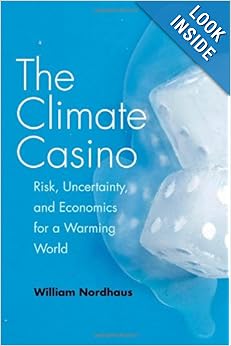 Climate change is profoundly altering our world in ways that pose major risks to human societies and natural systems. We have entered the Climate Casino and are rolling the global-warming dice, warns economist William Nordhaus. But there is still time to turn around and walk back out of the casino, and in this essential book the author explains how.
Climate change is profoundly altering our world in ways that pose major risks to human societies and natural systems. We have entered the Climate Casino and are rolling the global-warming dice, warns economist William Nordhaus. But there is still time to turn around and walk back out of the casino, and in this essential book the author explains how.
Bringing together all the important issues surrounding the climate debate, Nordhaus describes the science, economics, and politics involved—and the steps necessary to reduce the perils of global warming. Using language accessible to any concerned citizen and taking care to present different points of view fairly, he discusses the problem from start to finish: from the beginning, where warming originates in our personal energy use, to the end, where societies employ regulations or taxes or subsidies to slow the emissions of gases responsible for climate change.
Nordhaus offers a new analysis of why earlier policies, such as the Kyoto Protocol, failed to slow carbon dioxide emissions, how new approaches can succeed, and which policy tools will most effectively reduce emissions. In short, he clarifies a defining problem of our times and lays out the next critical steps for slowing the trajectory of global warming. (Amazon presentation).
![]()
Gambling with Civilization
Paul Krugman (November 7, 2013 issue)
Forty years ago a brilliant young Yale economist named William Nordhaus published a landmark paper, “The Allocation of Energy Resources,” that opened new frontiers in economic analysis.1 Nordhaus argued that to think clearly about the economics of exhaustible resources like oil and coal, it was necessary to look far into the future, to assess their value as they become more scarce—and that this look into the future necessarily involved considering not just available resources and expected future economic growth, but likely future technologies as well. Moreover, he developed a method for incorporating all of this information—resource estimates, long-run economic forecasts, and engineers’ best guesses about the costs of future technologies—into a quantitative model of energy prices over the long term.
The resource and engineering data for Nordhaus’s paper were for the most part compiled by his research assistant, a twenty-year-old undergraduate, who spent long hours immured in Yale’s Geology Library, poring over Bureau of Mines circulars and the like. It was an invaluable apprenticeship. My reasons for bringing up this bit of intellectual history, however, go beyond personal disclosure—although readers of this review should know that Bill Nordhaus was my first professional mentor. For if one looks back at “The Allocation of Energy Resources,” one learns two crucial lessons. First, predictions are hard, especially about the distant future. Second, sometimes such predictions must be made nonetheless.
Looking back at “Allocation” after four decades, what’s striking is how wrong the technical experts were about future technologies. For many years all their errors seemed to have been on the side of overoptimism, especially on oil production and nuclear power. More recently, the surprises have come on the other side, with fracking having the biggest immediate impact on markets, but with the growing competitiveness of wind and solar power—neither of which figured in “Allocation” at all—perhaps the more fundamental news. For what it’s worth, current oil prices, adjusted for overall inflation, are about twice Nordhaus’s prediction, while coal and especially natural gas prices are well below his baseline…. MORE
